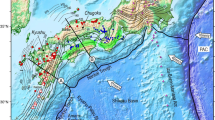Abstract
A new and detailed bathymetric map of the Myojinsho shallow submarine volcano provides a framework to interpret the physical volcanology of its 1952–1953 eruption, especially how the silicic pyroclasts, both primary and reworked, enlarged the volcano and were dispersed into the surrounding marine environment. Myojinsho, 420 km south of Tokyo along the Izu–Ogasawara arc, was the site of approximately 1000 phreatomagmatic explosions during the 12.5-month eruption. These explosions shattered growing dacite domes, producing dense clasts that immediately sank into the sea; minor amounts of pumice floated on the sea surface after some of these events. The Myojinsho cone has slopes of almost precisely 21° in the depth range 300–700 m.We interpret this to be the result of angle-of-repose deposition of submarine pyroclastic gravity flows that traveled downslope in all directions. Many of these gravity flows resulted from explosions and associated dome collapse, but others were likely triggered by the remobilization of debris temporarily deposited on the summit and steep upper slopes of the cone. Tephra was repeatedly carried into air in subaerial eruption columns and fell into the sea within 1–2 km of the volcano's summit, entering water as deep as 400 m. Because the fall velocity of single particles decreased by a factor of ∼30 in passing from air into the sea, we expect that the upper part of the water column was repeatedly choked with hyperconcentrations of fallout tephra. Gravitational instabilities within these tephra-choked regions could have formed vertical density currents that descended at velocities greater than those of the individual particles they contained. Upon reaching the sea floor, many of these currents probably continued to move downslope along Myojinsho's submarine slopes. Fine tephra was elutriated from the rubbly summit of the volcano by upwelling plumes of heated seawater that persisted for the entire duration of the eruption. Ocean currents carried this tephra to distal areas, where it presumably forms a pyroclastic component of deep-sea sediment.
Similar content being viewed by others
Author information
Authors and Affiliations
Additional information
Received: 5 December 1996 / Accepted: 17 September 1997
Rights and permissions
About this article
Cite this article
Fiske, R., Cashman, K., Shibata, A. et al. Tephra dispersal from Myojinsho, Japan, during its shallow submarine eruption of 1952–1953. Bull Volcanol 59, 262–275 (1998). https://doi.org/10.1007/s004450050190
Issue Date:
DOI: https://doi.org/10.1007/s004450050190




